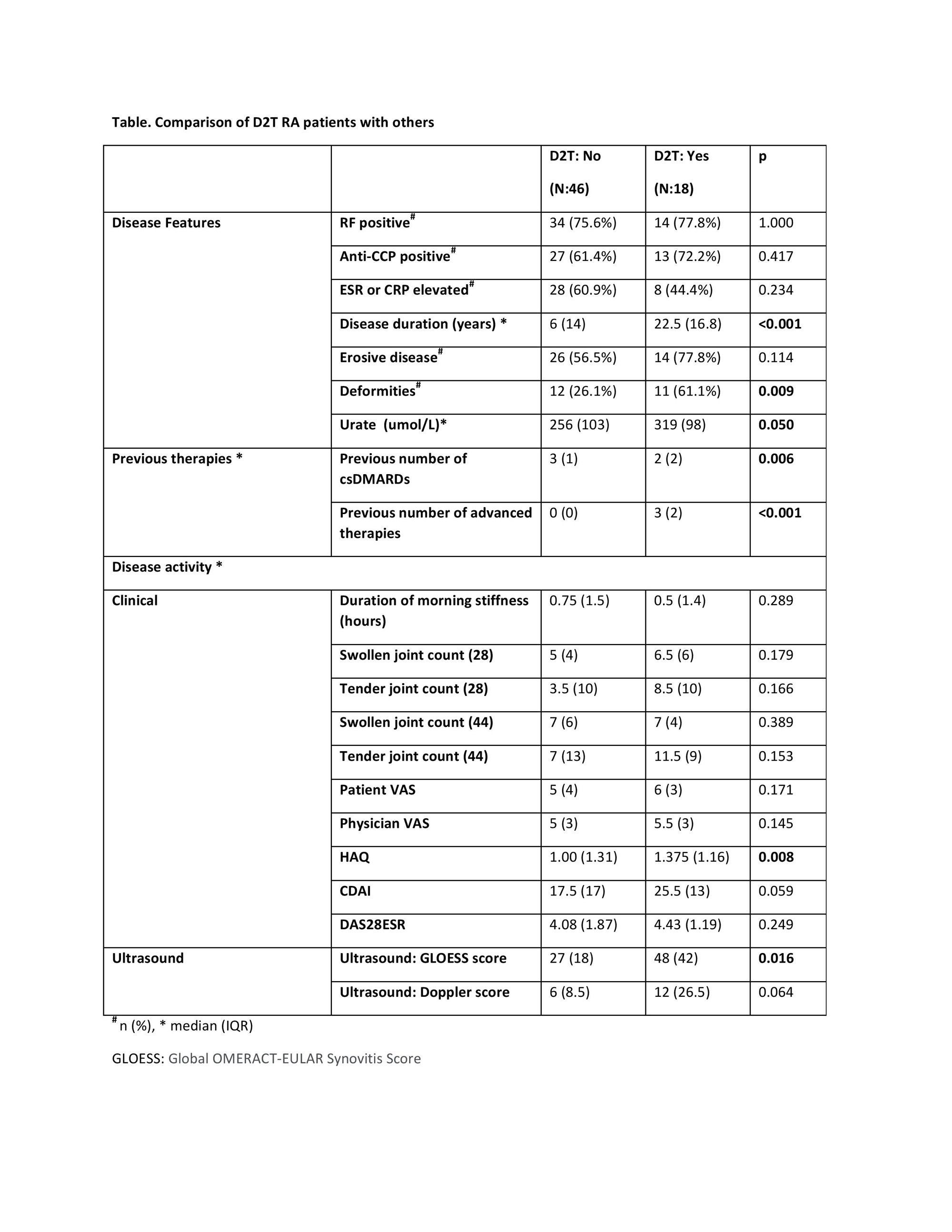Session Information
Session Type: Poster Session A
Session Time: 9:00AM-11:00AM
Background/Purpose: With increasing numbers of advanced therapies, rheumatologists frequently see Rheumatoid Arthritis (RA) patients who have failed ≥2 advanced therapies with different mechanisms of action. The management of difficult-to-treat (D2T)-RA patients is challenging, and there is an unmet need to understand the factors leading to D2T-RA. In this analysis, we aimed to compare the disease characteristics and activity of our D2T-RA patients with other RA patients who are starting a new advanced therapies for having active RA.
Methods: Within the ORCHESTRA Clinic (Ottawa Rheumatology CompreHEnSive TReartment and Assessment) at the Ottawa Hospital, all patients with inflammatory arthritis that are planning to initiate a new advanced therapy are assessed in a standardized fashion. Extensive data regarding disease history, medication exposure and disease activity measures are collected; the comorbidity burden is documented and managed. A protocoled ultrasound (US) of 36 joints is conducted at baseline and three-month intervals, until reaching clinical remission. All joints are scored using the Global OMERACT-EULAR Synovitis Score (GLOESS). For this analysis, the D2T-RA definitions were based on the EULAR definition and patients falling into this category had failed ≥2 biologics therapies1. Here we present the results from a pilot exploratory comparative analysis to identify the differences between the D2T-RA patients with the rest of the cohort.
Results: Among 64 RA patients included the study, 18 (28.1%) fulfilled the definition of D2T-RA. Demographic characteristics were similar between two groups, except female sex being slightly higher in D2T-RA patients and having longer disease duration (table). Seropositivity was similar across groups. DT2-RA patients had statistically significant more deformity in their joints than the rest of the group with higher HAQ scores and numerically more erosive disease. There were no differences between groups in terms of comorbidities, except urate levels being but significantly higher in D2T-RA patients (median (IQR): 319 umol/L (98) vs 256 umol/L (103); p=0.05). Regarding disease activity, D2T patients have numerically higher tender joint counts and CDAI scores. The GLOESS scores of D2T-RA patients on US were significantly higher with a trend to have higher Doppler scores (table).
Conclusion: In our D2T RA population, higher disease activity on US suggests an uncontrolled inflammatory process, which may or may not be complicated by centralized pain mechanisms. A greater portion of D2T patients were females, highlighting the importance of incorporating sex into research and understanding the factors leading to poor response in this group. Higher urate levels in D2T-RA may be due to increased disease duration, however, it would be noteworthy to look at the impact of urate crystals joint deposition in resistance to therapies. In addition,to date, fibromyalgia status is self-reported by our participants likely resulting in under-reporting. As this is a significant predictor of D2TRA, we will begin completing the Widespread Pain Index/Symptom Severity Scale in our cohort patients to better understand the predictors of D2TRA in our setting.
1.Nagy G.AnnRheumDis.2021
To cite this abstract in AMA style:
Gazel U, Acikgoz S, Ivory C, Zahrai A, Bayindir Tsechelidis O, Sabido-Sauri R, Hepworth E, aydin s. Patients with Difficult-to-treat Rheumatoid Arthritis Have Higher Levels of Inflammation on Ultrasound [abstract]. Arthritis Rheumatol. 2023; 75 (suppl 9). https://acrabstracts.org/abstract/patients-with-difficult-to-treat-rheumatoid-arthritis-have-higher-levels-of-inflammation-on-ultrasound/. Accessed .« Back to ACR Convergence 2023
ACR Meeting Abstracts - https://acrabstracts.org/abstract/patients-with-difficult-to-treat-rheumatoid-arthritis-have-higher-levels-of-inflammation-on-ultrasound/

